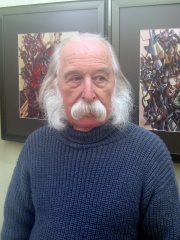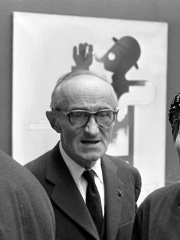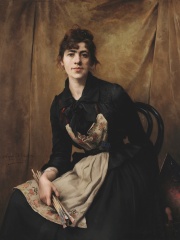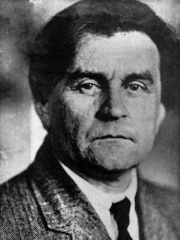
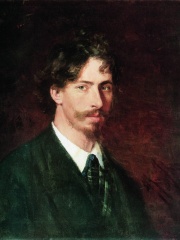
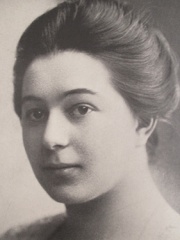
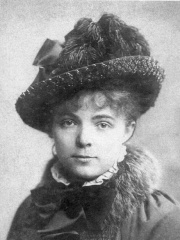
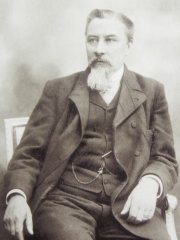
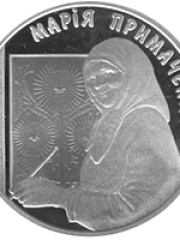
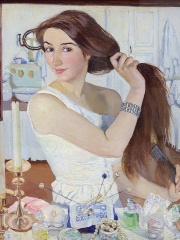
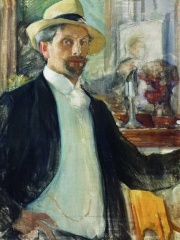
The Most Famous
PAINTERS from Ukraine
Top 10
The following people are considered by Pantheon to be the top 10 most legendary Ukrainian Painters of all time. This list of famous Ukrainian Painters is sorted by HPI (Historical Popularity Index), a metric that aggregates information on a biography's online popularity. Visit the rankings page to view the entire list of Ukrainian Painters.

1. Kazimir Malevich (1879 - 1935)
With an HPI of 79.25, Kazimir Malevich is the most famous Ukrainian Painter. His biography has been translated into 73 different languages on wikipedia.
Kazimir Severinovich Malevich (23 February [O.S. 11 February] 1879 – 15 May 1935) was a Russian avant-garde artist and art theorist, whose pioneering work and writing influenced the development of abstract art in the 20th century. His concept of Suprematism sought to develop a form of expression that moved as far as possible from the world of natural forms (objectivity) and subject matter in order to access "the supremacy of pure feeling" and spirituality. Born in Kiev, modern-day Ukraine, to an ethnic Polish family, Malevich was active primarily in Russia and became a leading artist of the Russian avant-garde. His work has been also associated with the Ukrainian avant-garde, and he is a central figure in the history of modern art in Central and Eastern Europe more broadly. Early in his career, Malevich worked in multiple styles, assimilating Impressionism, Symbolism, Fauvism, and Cubism through reproductions and the works acquired by contemporary Russian collectors. In the early 1910s, he collaborated with other avant-garde Russian artists, including Mikhail Larionov and Natalia Goncharova. After World War I, Malevich gradually simplified his approach, producing key works of pure geometric forms on minimal grounds. His abstract painting Black Square (1915) marked the most radically non-representational painting yet exhibited and drew "an uncrossable line (…) between old art and new art". Malevich also articulated his theories in texts such as From Cubism and Futurism to Suprematism (1915) and The Non-Objective World (1926). His trajectory mirrored the upheavals around the October Revolution of 1917. In 1918, Malevich began teaching in Vitebsk along with Marc Chagall. In 1919, he founded the UNOVIS artists collective and had a solo show at the Sixteenth State Exhibition in Moscow in 1919. His reputation spread westward with solo exhibitions in Warsaw and Berlin in 1927. This marked the first and only time Malevich ever left Russia. From 1928 to 1930 he taught at the Kiev Art Institute alongside Alexander Bogomazov, Victor Palmov, and Vladimir Tatlin, while publishing in the Kharkiv magazine Nova Generatsiia (New Generation). Repression of the intelligentsia soon forced him back to Leningrad. By the early 1930s, Stalin's restrictive cultural policy and the subsequent imposition of Socialist Realism had prompted Malevich to return to figuration and to paint in a representational style. Diagnosed with cancer in 1933, he was not allowed to leave the Soviet Union to seek treatment abroad. While constrained by his progressing illness and Stalin's cultural policies, Malevich painted and exhibited his work until his death. He died from cancer on 15 May 1935, at age 56. His art and his writings influenced Eastern and Central European contemporaries such as El Lissitzky, Lyubov Popova, Alexander Rodchenko and Henryk Stażewski, as well as generations of later abstract artists, such as Ad Reinhardt and the Minimalists. He was celebrated posthumously in major exhibits at the Museum of Modern Art (1936), the Guggenheim Museum (1973), and the Stedelijk Museum in Amsterdam (1989), which has a large collection of his work. In the 1990s, the ownership claims of museums to many Malevich works began to be disputed by his heirs.

2. Ilya Repin (1844 - 1930)
With an HPI of 78.69, Ilya Repin is the 2nd most famous Ukrainian Painter. His biography has been translated into 82 different languages.
Ilya Yefimovich Repin (5 August [O.S. 24 July] 1844 – 29 September 1930) was a Ukrainian-born Russian painter. He became one of the most renowned artists in Russia in the 19th century. His major works include Barge Haulers on the Volga (1873), Religious Procession in Kursk Province (1880–1883), Ivan the Terrible and His Son Ivan (1885), and Reply of the Zaporozhian Cossacks (1880–1891). He is also known for the revealing portraits he made of the leading Russian literary and artistic figures of his time, including Mikhail Glinka, Modest Mussorgsky, Pavel Tretyakov, and especially Leo Tolstoy, with whom he had a long friendship. Repin was born and brought up in Chuguev, then part of the Russian Empire. His father had served in an Uhlan regiment in the Russian army and then sold horses. Repin began painting icons at age sixteen. He failed at his first effort to enter the Imperial Academy of Fine Arts in Saint Petersburg, but went to the city anyway in 1863, audited courses, and won his first prizes in 1869 and 1871. In 1872, after a tour along the Volga River, he presented his drawings at the Academy of Art in St. Petersburg. Grand Duke Vladimir Alexandrovich awarded him a commission for a large scale painting, The Barge Haulers of the Volga, which launched his career. He spent two years in Paris and Normandy, seeing the first Impressionist expositions and learning the techniques of painting in the open air. He suffered one setback in 1885 when his history portrait of Ivan the Terrible killing his own son in a fit of rage caused a scandal, resulting in the painting being removed from exhibition. But this was followed by a series of major successes and new commissions. In 1898, with his second wife, he built a country house, which he called "The Penates" ('Penaty' in Russian) in the village of Kuokkala, Finland, where they entertained Russian society. The house and garden now constitute the Penaty Memorial Estate and the village and district were renamed to Repino, now a suburban area of Russia's Saint Petersburg. In 1905, following the repression of street demonstrations by the Imperial government, he quit his teaching position at the Academy of Fine Arts. He welcomed the February Revolution in 1917, but was appalled by the violence and terror unleashed by the Bolsheviks following the October Revolution. Later that year, Finland declared its independence from Russia. Following this event, Repin was unable to travel to St. Petersburg (renamed Leningrad), even for an exhibition of his own works in 1925. Repin died on 29 September 1930, at the age of 86, and was buried at the Penates. His home is now a museum and a UNESCO World Heritage Site.

3. Sonia Delaunay (1885 - 1979)
With an HPI of 71.78, Sonia Delaunay is the 3rd most famous Ukrainian Painter. Her biography has been translated into 41 different languages.
Sonia Delaunay (French: [sɔnja dəlonɛ]; 14 November 1885 – 5 December 1979) was a French artist born to Jewish parents, who spent most of her working life in Paris. She was born in the Russian Empire, now Ukraine, and was formally trained in Russia and Germany, before moving to France and expanding her practice to include textile, fashion, and set design. She was part of the School of Paris and co-founded the Orphism art movement, noted for its use of strong colours and geometric shapes, with her husband Robert Delaunay and others. She was the first living female artist to have a retrospective exhibition at the Louvre in 1964, and in 1975 was named an officer of the French Legion of Honor. Her work in modern design included the concepts of geometric abstraction, and the integration of furniture, fabrics, wall coverings, and clothing into her art practice.

4. Marie Bashkirtseff (1858 - 1884)
With an HPI of 69.49, Marie Bashkirtseff is the 4th most famous Ukrainian Painter. Her biography has been translated into 38 different languages.
Marie Bashkirtseff, born Maria Konstantinovna Bashkirtseva (Russian: Мария Константиновна Башкирцева; 24 November [O.S. 12 November] 1858 – 31 October 1884), was an émigré artist who was born into a noble family on their estate near the city of Poltava. She lived and worked in Paris, and died at the age of 25.
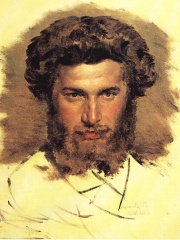
5. Arkhip Kuindzhi (1842 - 1910)
With an HPI of 66.80, Arkhip Kuindzhi is the 5th most famous Ukrainian Painter. His biography has been translated into 45 different languages.
Arkhip Ivanovich Kuindzhi (Russian: Архип Иванович Куинджи [ɐrˈxʲip kʊˈindʐɨ]; Ukrainian: Архи́п Іва́нович Куї́нджі [ɑrˈxɪp kʊˈindʐɨ]; Greek: Αρχίπ Ιβάνοβιτς Κουίντζι; 27 January [O.S. 15 January] 1841 – 24 July [O.S. 11 July] 1910) was a Russian landscape painter of Urum (Crimean Greek) origin.

6. Henryk Siemiradzki (1843 - 1902)
With an HPI of 66.69, Henryk Siemiradzki is the 6th most famous Ukrainian Painter. Her biography has been translated into 30 different languages.
Henryk Hektor Siemiradzki (24 October 1843 – 23 August 1902) was a Polish painter. He spent most of his active creative life in Rome. Best remembered for his monumental academic art, he is particularly known for his depictions of scenes from the ancient Greco-Roman world and the New Testament, owned by many national galleries of Europe. Many Siemiradzki paintings depict scenes from antiquity, often the sunlit pastoral scenes or compositions presenting the lives of early Christians. He also painted biblical and historical scenes, landscapes, and portraits. His best-known works include monumental curtains for the Lviv (Lwów) Theatre of Opera and for the Juliusz Słowacki Theatre in Kraków.

7. Maria Prymachenko (1908 - 1997)
With an HPI of 66.31, Maria Prymachenko is the 7th most famous Ukrainian Painter. Her biography has been translated into 44 different languages.
Maria Oksentiyivna Prymachenko (Ukrainian: Марія Оксентіївна Примаченко; 12 January 1909 [O.S. 30 December 1908] – 18 August 1997) was a Ukrainian folk art painter, who worked in the naïve art style. A self-taught artist, she worked in painting, embroidery and ceramics. In 1966, Prymachenko was awarded the Taras Shevchenko National Prize of Ukraine. The United Nations Educational, Scientific and Cultural Organization (UNESCO) declared that 2009 was the year of Prymachenko. A street in Kyiv and a minor planet are both named after her. Pablo Picasso once said, after visiting a Prymachenko exhibition in Paris at the 1937 World's Fair, "I bow down before the artistic miracle of this brilliant Ukrainian."

8. Zinaida Serebriakova (1884 - 1967)
With an HPI of 66.03, Zinaida Serebriakova is the 8th most famous Ukrainian Painter. Her biography has been translated into 37 different languages.
Zinaida Yevgenyevna Serebriakova (Russian: Зинаида Евгеньевна Серебрякова; née Lansere (Лансере), called in French Zénaïde Lanceray; 10 December [O.S. 28 November] 1884 – 19 September 1967) was a Russian painter.

9. Leonid Pasternak (1862 - 1945)
With an HPI of 64.33, Leonid Pasternak is the 9th most famous Ukrainian Painter. His biography has been translated into 31 different languages.
Leonid Osipovich Pasternak (Russian: Леонид Осипович Пастернак; born Yitzhok-Leib or Isaak Iosifovich Pasternak; 3 April [O.S. 22 March] 1862 – 31 May 1945) was a Russian painter. He was the father of the poet and novelist Boris Pasternak.
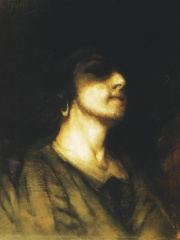
10. Maurycy Gottlieb (1856 - 1879)
With an HPI of 63.80, Maurycy Gottlieb is the 10th most famous Ukrainian Painter. His biography has been translated into 21 different languages.
Maurycy Gottlieb (; 21 February 1856 – 17 July 1879) was a Polish-Jewish realist painter of the Romantic period. Considered one of the most talented students of Jan Matejko, Gottlieb died at the age of 23.
People
Pantheon has 30 people classified as Ukrainian painters born between 1735 and 1936. Of these 30, 1 (3.33%) of them are still alive today. The most famous living Ukrainian painters include Ivan Marchuk. The most famous deceased Ukrainian painters include Kazimir Malevich, Ilya Repin, and Sonia Delaunay.
Living Ukrainian Painters
Go to all RankingsDeceased Ukrainian Painters
Go to all RankingsKazimir Malevich
1879 - 1935
HPI: 79.25
Ilya Repin
1844 - 1930
HPI: 78.69
Sonia Delaunay
1885 - 1979
HPI: 71.78
Marie Bashkirtseff
1858 - 1884
HPI: 69.49
Arkhip Kuindzhi
1842 - 1910
HPI: 66.80
Henryk Siemiradzki
1843 - 1902
HPI: 66.69
Maria Prymachenko
1908 - 1997
HPI: 66.31
Zinaida Serebriakova
1884 - 1967
HPI: 66.03
Leonid Pasternak
1862 - 1945
HPI: 64.33
Maurycy Gottlieb
1856 - 1879
HPI: 63.80
Cassandre
1901 - 1968
HPI: 63.16
Anna Bilińska
1854 - 1893
HPI: 62.09
Overlapping Lives
Which Painters were alive at the same time? This visualization shows the lifespans of the 25 most globally memorable Painters since 1700.

